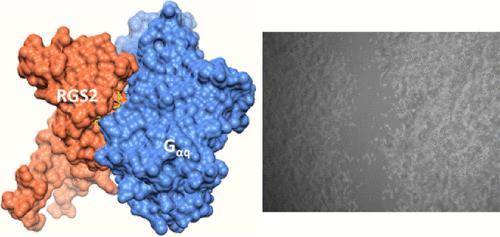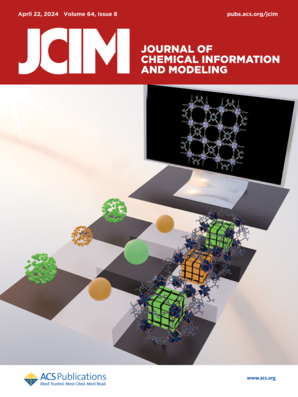In Silico Design of Novel RGS2–Galpha-q Interaction Inhibitors with Anticancer Activity
IF 5.6
2区 化学
Q1 CHEMISTRY, MEDICINAL
引用次数: 0
Abstract
Regulators of G-protein signaling (RGS) are a family of approximately 30 proteins that bind to and deactivate the alpha subunits of G-proteins (Gα) by accelerating their GTP hydrolysis rates, which terminates G-protein coupled receptor (GPCR) signaling. Thus, RGS proteins are essential in regulating GPCR signaling, and most members are implicated as critical nodes in human diseases such as hypertension, depression, and others. Regulator of G-protein signaling 2 (RGS2), a member of the R4 family of RGS proteins, is overexpressed in many solid breast cancers, and its levels in prostate cancer significantly correlate with the metastatic stage and poor prognosis. We sought to develop RGS2 inhibitors as potential chemotherapeutic agents utilizing structure-based drug design approaches. Available structures of the RGS2-Gα complex were used to extract a pharmacophore model for searching chemical databases. Docking of identified hits to RGS2 as well as other RGS structures was used to screen the hits for potent and selective RGS2 inhibitors. Whole cell assays showed the top 10 ranking compounds, AJ-1–AJ-10, to inhibit RGS2–Gαq interactions. Differential scanning fluorimetry showed AJ-3 to bind RGS2 but not Gαq. All 10 compounds inhibited the growth of several RGS2 expressing cancers in cell culture assays. In addition, AJ-3 inhibited the migration of LNCaP prostate cancer cells in wound healing assays. This is the first group of RGS2 inhibitors identified by structure-based approaches and that show anticancer activity. These results highlight the potential RGS2 inhibitors have to be a new class of chemotherapeutic agents.

具有抗癌活性的新型 RGS2-Galpha-q 相互作用抑制剂的硅学设计
G 蛋白信号转导调节蛋白(RGS)是一个由大约 30 种蛋白组成的家族,它们通过加快 GTP 的水解速度与 G 蛋白(Gα)的α亚基结合并使其失活,从而终止 G 蛋白偶联受体(GPCR)的信号转导。因此,RGS 蛋白在调节 GPCR 信号转导方面至关重要,其大多数成员被认为是高血压、抑郁症等人类疾病的关键节点。G 蛋白信号转导调节器 2(RGS2)是 RGS 蛋白 R4 家族的一个成员,在许多实体乳腺癌中过表达,而在前列腺癌中其水平与转移期和不良预后显著相关。我们试图利用基于结构的药物设计方法开发 RGS2 抑制剂,作为潜在的化疗药物。我们利用 RGS2-Gα 复合物的现有结构提取了一个药理模型,用于搜索化学数据库。对已确定的 RGS2 和其他 RGS 结构进行对接,筛选出强效和选择性的 RGS2 抑制剂。全细胞测定显示,排名前 10 位的化合物 AJ-1-AJ-10 能够抑制 RGS2-Gαq 的相互作用。差示扫描荧光测定法显示,AJ-3 能与 RGS2 结合,但不能与 Gαq 结合。在细胞培养试验中,所有 10 种化合物都抑制了几种表达 RGS2 的癌症的生长。此外,在伤口愈合试验中,AJ-3 还能抑制 LNCaP 前列腺癌细胞的迁移。这是第一组通过基于结构的方法鉴定出的具有抗癌活性的 RGS2 抑制剂。这些结果凸显了 RGS2 抑制剂成为一类新型化疗药物的潜力。
本文章由计算机程序翻译,如有差异,请以英文原文为准。
求助全文
约1分钟内获得全文
求助全文
来源期刊
CiteScore
9.80
自引率
10.70%
发文量
529
审稿时长
1.4 months
期刊介绍:
The Journal of Chemical Information and Modeling publishes papers reporting new methodology and/or important applications in the fields of chemical informatics and molecular modeling. Specific topics include the representation and computer-based searching of chemical databases, molecular modeling, computer-aided molecular design of new materials, catalysts, or ligands, development of new computational methods or efficient algorithms for chemical software, and biopharmaceutical chemistry including analyses of biological activity and other issues related to drug discovery.
Astute chemists, computer scientists, and information specialists look to this monthly’s insightful research studies, programming innovations, and software reviews to keep current with advances in this integral, multidisciplinary field.
As a subscriber you’ll stay abreast of database search systems, use of graph theory in chemical problems, substructure search systems, pattern recognition and clustering, analysis of chemical and physical data, molecular modeling, graphics and natural language interfaces, bibliometric and citation analysis, and synthesis design and reactions databases.

 求助内容:
求助内容: 应助结果提醒方式:
应助结果提醒方式:


